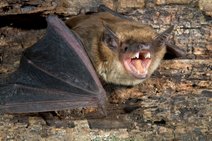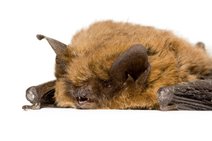Fun Animal Fact of the Month: Bats are the only mammal that can fly.

Tis the season for bats. Spring is here and the bats are searching for a place to raise their young. Every year about this time, we begin to get an increase in bat calls. There birthing period begins in late May and hence their search for a safe place to raise their pups. There are two types of bats most commonly found in our service areas, the big brown bat and the little brown bat.
The big brown bat is 4 to 5 inches long, weighing 3/8 to 5/8 of an ounce having a 12” wingspan. The little brown bat is 3 to 4 inches long, weighing 1/16 to ½ ounce having a 9” wingspan. The little brown bat is New York’s most abundant species of bat. Both the big and little brown bat have a brownish nose, long hairs on their toes and their Calcar usually lacks keel or only has a weak keel. The Calcar is the bone that juts back from the anklebone to support the tail membrane. It’s “keeled” if there’s a flat ridge of skin sticking off its side that looks like the keel of a boat.
Females of both bat species are colonial, while the males are usually solitary or found in small bachelor groups. Females roost together to raise their young. Pregnant females look for a hot niche within the roost that will serve as an incubator. These maternity colonies are often found in attics, soffits, wall voids, behind chimneys, in barns, tree cavities, rock crevices, and caves. Bats are nocturnal with peak feeding at dusk and dawn (crepuscular). After feeding in the early morning, they’ll return to the daytime roost and hang out, in a slightly dormant state. After their evening feeding, they’ll usually rest. Females return to the roost often to nurse their young. Both bats hibernate in colonies in caves, mines, and deep rock crevices. Big browns will also hibernate in buildings. The body temperatures of both species drops to within several degrees of the “room temperature.” Big brown bats can tolerate below-freezing temperatures for short periods, which is why they are often found roosting in buildings. Their heart rates also drop dramatically. The little brown’s will fall below 20 beats/minute and the big brown’s to 42–62 beats/minute. Compare that to their heart rates during the rest of the year: 250–450 beats/minute for bats when they’re resting, 800+ beats/minute when they’re flying.
Bats may be found in forests and forest edges, areas with lakes and ponds, parks, orchards, fields, suburbs and cities. Bats are polygamous. Females raise young by themselves (although they share the roost with other females and their young). Bats have an unusual habit. They mate during the fall, but the females store the sperm in their bodies for months. Fertilization doesn’t take place until the late winter or early spring, when the bats emerge from hibernation or return from the south. Bats give birth in late May through early July. The little brown bat will give birth to 1 pup and the big brown bat typically has 2 pups.
Bats are wonderful mammals that play a crucial role in our ecological systems. Bats consume enormous quantities of mosquitoes and other insects such as beetles, moths and leaf hoppers. Why are they so beneficial? Because they reduce the risk of humans contacting the diseases carried by mosquitoes, i.e. West Nile Virus and they naturally protect food crops that we all benefit from eating. At Wildlife Busters all of our bat removal techniques are environmentally friendly and ecologically safe to ensure that only humane bat control is practiced. Under no circumstances are poisons or chemicals ever used or needed to properly remove a bat or bat colony. One of our main ways to remove bats is by installing a one-way exclusionary door made specifically for certain areas for the bats entry. This door allows the bats to leave, but not come back. Hence, we do not recommend removing bats beginning in late May/ early June through August when their pups might be left behind.
Bats Best Practices
Prevention is always the best way to avoid human/wildlife conflicts. At Wildlife Busters we offer bat prevention plans. Bats bodies are made of cartilage and hence they are master contortionists—they can squeeze through a hole the size of a dime. Our wildlife technicians are trained to locate these access points throughout your commercial or residential property. We will come in and perform a thorough site inspection of your home and seal all entryways. All of our prevention plans come with a 1 to 5 year warranty. Please don’t hesitate to call us at our toll free number 855-945-1212 to set up an appointment.
…And just for informational purposes, the disease that impacts the bats of our service area is called White Nose Syndrome. It truly is a wildlife health crisis, white nose syndrome, is named for the white fungus evident on the muzzles and wings of affected bats. Scientists are still researching and learning about the disease, but they believe it causes the reduction of fat reserves, which they need to survive through their hibernation period. This causes them to leave their hibernacula during the winter prematurely and die. Some signs of white nose syndrome in bats include
- White fungus, especially on the bat’s nose, but also on the wings, ears and tail
- Bats flying outside during the day in temperatures at or below freezing
- Bats clustered near the entrance of a hibernacula
- Dead or dying bats on the ground or on building, trees or other structures.
If you have seen bats with these characteristics, please notify your local DEC office.
If you are experiencing a bat removal issue or just want to get a jump-start on preventing an issue from arising, please contact us toll free at 855-945-1212. We look forward to resolving your animal control issue in a professional and humane manner.
If you are experiencing a nuisance wildlife issue, whether it be raccoons, squirrels, woodchucks, moles, voles, bats, give Wildlife Busters a call toll free at 855-945-1212 and we resolve your wildlife management issue professionally, efficiently and humanely. Please note that all of our wildlife exclusion services come with a 1 to 5 year warranty which can be extended upon expiration with one of our long-term prevention plans. Please contact us.
Community Wildlife Programs and Upcoming Events
Mohonk Preserve
Saturday June 4th, “Inspired by Nature Writing Workshop” 1 pm – 3:30pm. Saturday June 11th, “Mohonk Preserve Annual Benefit Auction” 5pm on. Saturday June 18, “21st Century Dragons and Damsels: Up Close and Personal” 9:30 am to 12 noon. Sunday June 26th, “Dog Days of Summer Family Hike” 1 pm – 3 pm. Tuesday June 28th, “Toddlers on the Trail What’s Blooming” 10 am – 12 noon. For more information please visit www.mohonkpreserve.org.
Museum of Hudson Highlands
Saturday June 4th. Fish of the Hudson begins 10 am. Saturday June 11th, Year of the Turtle begins 10 am. Saturday June 18th Toads begins 10 am. Saturday June 25th Adult Butterfly Walk begins 10 am. For more information please visit: www.museumhudsonhighlands.org
Weinberg Nature Center
Sundays June 5th & 12th, “Meet our Resident Animals”, 11 am to 12 pm and 2 pm to 3pm. Saturday June 4th, “Nature Lovers and Artists” 10 am – 11:30 am. Saturday June 4th. “Yoga for Kids” from 11 am to 12 pm. For more information please visit: www.weinbergnaturecenter.org
Beczak Environmental Education Center
Sunday June 5th, “Incredible Insects” 11 am 12 noon. Saturday June 18th and Sunday June 19th, “Bird Wonders” 11 am – 12 noon. Saturday June 11th,, Sunday June 12th and Saturday June 25th and Sunday June 26th, “Hudson River Family Seining”, 12 pm – 2 pm. For more information please visit: www.beczak.org
And for some Wildlife fun all year round visit:
www.palisadesparksconservancy.org The Bear Mountain Zoo located in the Bear Mountain State Park, NY
“I would rather have a mind opened by wonder than one closed by belief.” Gerry Spence


 Receive FREE wildlife Tips!
Receive FREE wildlife Tips!
